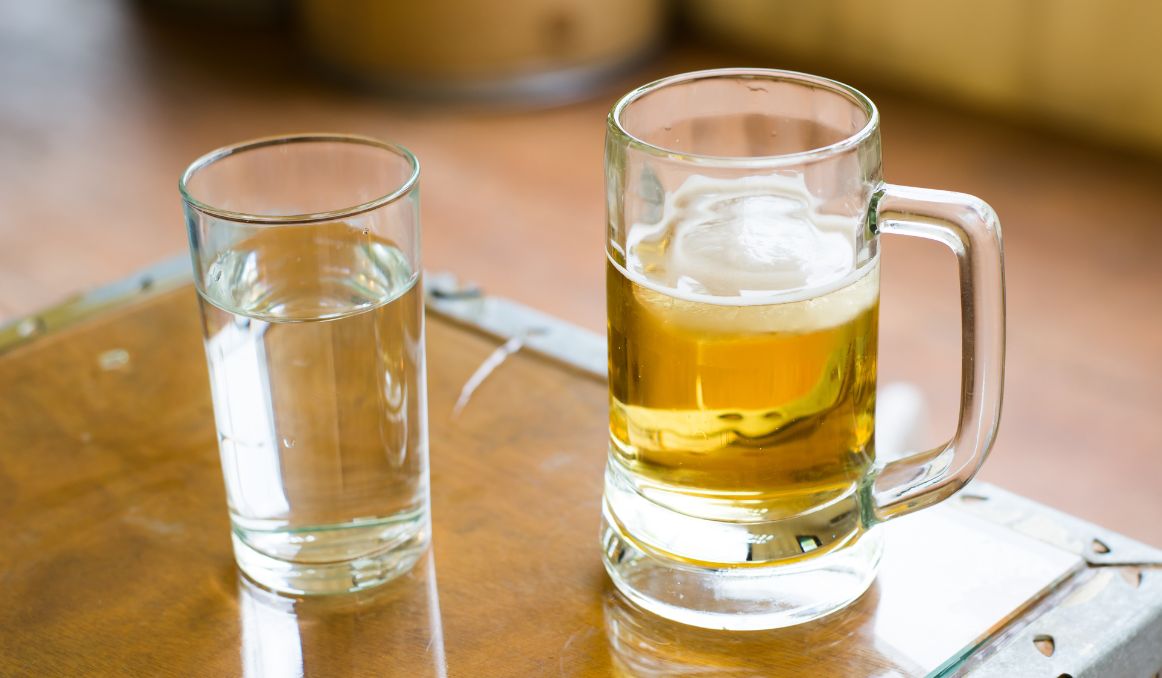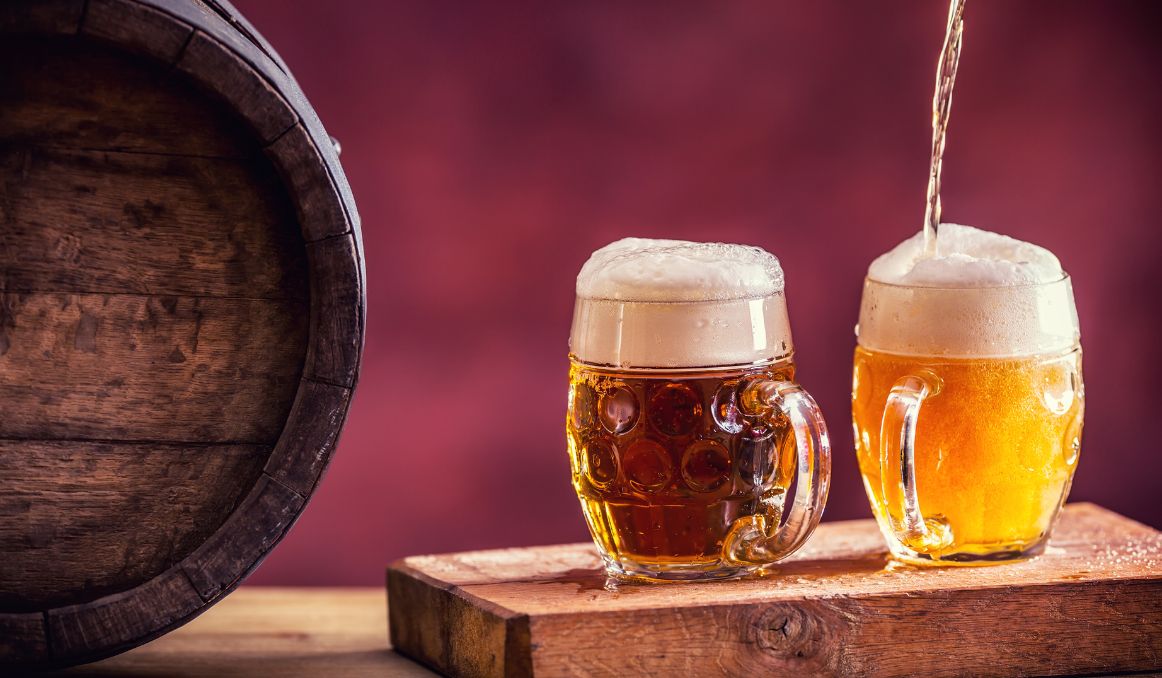What Percentage of Beer Is Water?
What percentage of beer is water? And why does it matter? Ever since we were told that we had to drink 8 eight-ounce glasses of water every day, we have been asking what counts as a glass of water. Juice? Soda? Tea? Coffee? Beer?
And it’s a fair question. If the base of all of these beverages is water, why shouldn’t they count as water intake?
After all, 95% of beer is water. That’s right. 95%!

How Beer Is Made with Water
When you think about it, beer is basically grain tea.
Beer was discovered, not invented, accidentally thousands of years ago.
Approximately 10,000 years ago, humans realized they could quit chasing food in the form of hunting and gathering and instead irrigate land, grow crops, and domesticate farm animals.
Now, they could build safe houses, live communally, taking advantage of cooperation and participation that highlighted individual skills and the contributions each person could make to the community.
One of the most important skills was farming.
Cereal grains were among the first crops to be grown because they are easy to cultivate, easy to preserve, and highly nutritious.
From a single cereal grain crop of wheat, barley, or oats, meals could be made, breads could be baked, and animals could be fed.
One common dish made from toasted cereal grains, which brought out the sweetness of the grain, was a meal that consisted of boiled grain with milk or butter added.
Think of oatmeal or cream of wheat.
Eventually, large batches would be made in advance.
From there, all it took was for someone to leave out a batch of this boiled grain long enough before it became a fermented dish.
Local wild yeast would have been attracted to the fermentable sugars in the grain meal, it would have consumed those sugars and converted them to alcohol and carbon dioxide.
Now you have beer.
That’s really all it took.
Well, that and one person to try this now fermented food, enjoy the euphoric effects, and begin mastering the craft of beer.
So you see, beer is really just grain boiled in water with the grain filtered out. So… nutritious water.
Then the yeast adds just a touch of alcohol to that water, on average 5%, so… still nutritious alcoholic water.
Which means you can definitely count beer as your water intake, right?
Not so fast.
Does Beer Count as Water Intake?

If not for the alcohol, yes, you could count beer as part of your water intake. Most modern medical advice says you can count 2 of your recommended 8 glasses of water a day using beverages that are mostly water. The key to staying hydrated is water plus salt plus sugar. So, a cup of coffee or tea or juice can absolutely count as hydration.
The problem with beer counting as water?
Alcohol is dehydrating.
Basically, for all the hydration you get from that 95% water, you get even more dehydration from alcohol.
You see, alcohol acts as a diuretic. When you drink it, it removes fluids from your blood through your renal system – your kidneys, ureters, and bladder – much more quickly than do other liquids.
Thus, not only is alcohol not hydrating, but if you don’t drink extra water with beer or any other alcohol, you can quickly become dehydrated.
Most people notice the common signs of dehydration as a hangover.
You’re tired and sluggish, you feel thirsty, and you have a headache. You’re also likely irritable.
The good news is that beer is likely the least dehydrating of all alcoholic beverages as it is one of the lowest in alcohol. The higher the ABV, the more dehydrating the beverage.
So, there’s that.
What Happens when You Freeze Beer
Another interesting tidbit about beer and water is that if you freeze beer, it separates the alcohol from the water in the beer.
Which is why, unless you’re planning on making beer margaritas (yes, that’s a thing), you’ll want to avoid ever freezing your beer.
Because alcohol is pure ethanol, and ethanol has a super low freezing point (-173.2 degrees Fahrenheit), the alcohol in your beer will remain liquid while the water, which freezes at 32 degrees Fahrenheit, will freeze solid.
Furthermore, the carbonation in your beer (oh yea! Beer is carbonated!) will expand, causing whatever vessel you have the beer in to explode.
Now you have a messy freezer and useless beer.
Nobody wants that.
Beer Is not Health Food
It can be tempting to try to add our favorite treats and indulgences to the list of healthy foods in this crazed diet culture and increasingly health-conscious world.
But honestly, unless we’re talking about people in the 1500s making beer as a nutritious way to drink liquids because they had no clean running water and suffered from food shortages, you cannot count beer as a health food.
It also pays to remember that the beer those people were drinking was even lower in alcohol content, like close to 1%.
Nothing like your 8% ABV pilsner.
And that’s okay!
It is much more stressful to constantly count every calorie, every glass of water, every nutrition fact, than it is to simply enjoy the occasional beer because you want to have a beer with your friends and you like beer!
No one is trying to turn chocolate cake into health food. And we still like that.
Just let beer be beer and make sure you drink in moderation and support your renal system with actual water.
Cheers!
Passionate about the beer and/or wine making process? So are we! If you’re interested in finding out how you can use our technology to control fermentation and monitor your yeast, save work hours and improve the cost-efficiency of your business, drop us a line at [email protected] or check out our product pages:
- Oculyze BB 2.0 (Better Brewing) Yeast Cell Counter App + Hardware
- Oculyze FW (Fermentation Wine) Yeast Cell Counter App + Hardware
Also, you can now get access to a fully functional demo account to test your yeast via our Web App. Completely free of charge and with no commitment to purchase.
Sources:
Stay on top on important fermentation insights – subscribe to our monthly newsletter and receive a hand-picked selection of our most relevant articles straight to your inbox.
Never miss a beat and get real time updates with a new article each workday by subscribing our social media channels.
Instagram | Facebook | Twitter | YouTube


